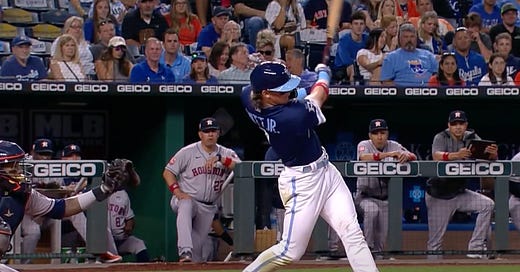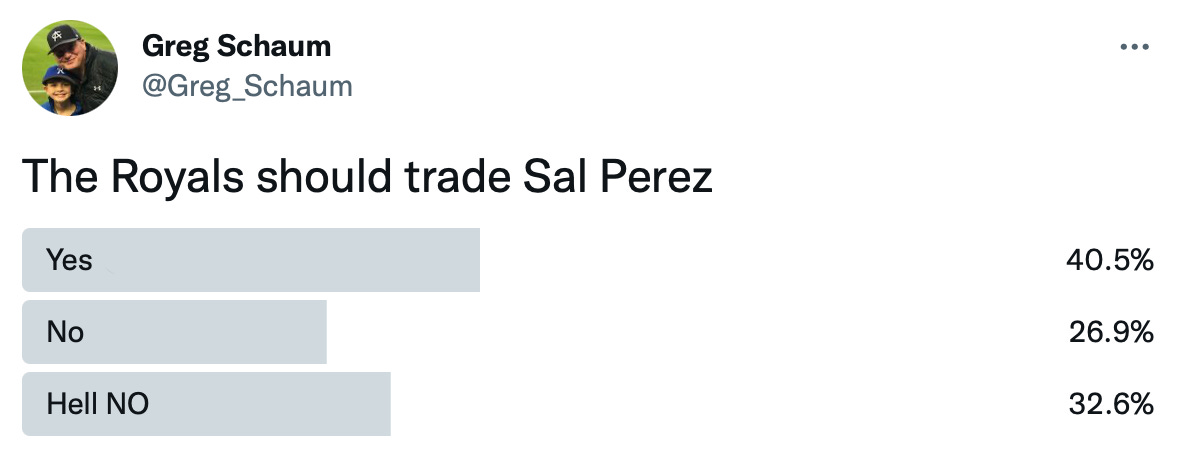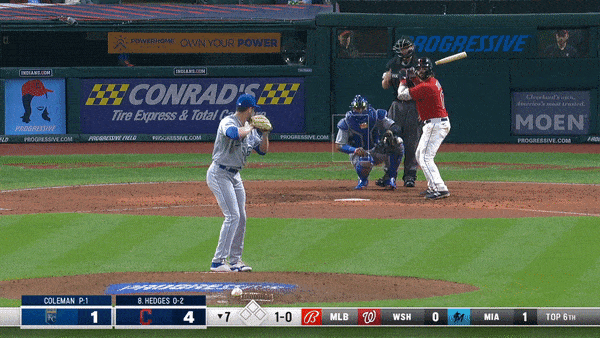Royals trade value
With the Royals getting transactional, it's time for a ranking of their top 20 players who would bring the largest return in a trade.
After sitting out the free agency portion of the winter, it appears the Royals have properly kicked off the trade market. In two separate deals this week they’ve dealt their starting center fielder and oft-injured shortstop for a trio of bullpen arms. The return for both players is about what you would expect, given their contract status and most recent performance history.
Inspired by the Royals suddenly getting transactional, I decided to take a stab at ranking the top 20 Royals based on their current trade value. Taking my cue from Fangraphs and their annual trade value series, the players are ranked by what I perceive to be the best return the Royals would receive if they chose to include that player in a deal. The rankings are based on a combination of major league track record, prospect pedigree, age and contract status.
Obviously, not everyone on this list is on the block. Nor should they be. And this isn’t a list of who should be traded. This is simply a look at who I believe would net the Royals the best return in a deal.
Got it? Let’s roll…
We start with a few guys who didn’t come close to my Top 20.
Salvador Perez
Perez is guaranteed $64 million over the next three years and remains a physical marvel at the age of 33.
Catching is a position where there is always demand. Perez’s leadership, work ethic and playoff experience are intangibles that could move the trade value needle. But it can’t overcome the fact that he’s, you know, a 33-year-old catcher.
I thought this poll was interesting.
We keep saying that Perez is going to have to move off the position, but the dude continually amazes and has an insatiable hunger to catch. When I think of catchers who had extended careers behind the plate in the last couple of decades, I think of Iván Rodríguez and Yadier Molina. Both were catching at age 39. Both became below-average offensive performers at age 32.
Brad Keller
A free agent after the upcoming season, he was a non-tender candidate this winter. He’s not an innings-eater. Nor is he a strikeout artist.
With middling performance, poor peripherals and one year of team control left, there’s not a lot of value here. Especially at $5.775 million for 2023.
Hunter Dozier
Any trade scenario involving Dozier includes some unpleasantries. The Royals would either have to eat most of the contract, package a player with him you don’t want to lose but who brings actual value or they’d have to swap one bad contract for another.
I’d choose option C but it would probably be easier to just cut him loose.
Honestly, it doesn’t feel like much separates numbers 11 through 20. For the sake of brevity, let’s group them here.
20. Nick Loftin
19. Tyler Gentry
18. Amir Garrett
17. Angel Zerpa
16. Frank Mozzicato
15. Kyle Isbel
14. Nick Pratto
13. Ben Kudrna
12. Maikel Garcia
11. Taylor Clarke
A contact and speed guy, Loftin struggled against Triple-A pitching last summer and saw his strikeout rate jump. Gentry hit .321/.417/.555 in 73 games at Northwest Arkansas last year and is ready for the bump to Triple-A. A year from becoming a free agent, Garrett displayed his typical control issues last season. At 22, Zerpa has had a couple cups of coffee and now projects as a back-of-the-rotation starter. Mozzicato and Kudrna are raw pitching prospects who should stick in the rotation. Isbel may very well be the Royals starting centerfielder—the metrics love his defense. It was a disappointing debut for Pratto last summer, which hurts him here for the time being. I’m extremely bullish on Garcia and am left wondering if I should’ve rated him higher on this list. Clarke flashes elite control and has three years before he hits free agency as a solid, if unspectacular, bullpen piece.
Ok…On to the top 10.
10. Nicky Lopez
The temptation is to make a comp to recently traded Michael A. Taylor in that both are defense-first role players. Lopez doesn’t strike out as much, but his lack of ability to drive a baseball is undercut by his 7 percent walk rate. I’m also at a loss to explain how the guy has posted a BABIP below .275 in three of his four big league seasons. With his speed and ability to make contact, it should be a lot higher.
Lopez was eligible for arbitration for the second time this offseason and as a Super Two will go through the process two more times before hitting the free agent market after 2025. He is due to earn $3.7 million this season.
The White Sox are supposedly interested in his services. Pedro Grifol is a monster.
9. Dylan Coleman
Coleman throws a 98 MPH sinker and a 97.5 MPH four-seamer. He has just over a year of service time which makes him insanely affordable for the next two seasons before he becomes eligible for arbitration.
He’s struck out a quarter of the batters he’s faced since his debut in 2021, keeps the ball in the yard and owns a 2.66 ERA in 74.1 innings.
He struggled with his control at times last season (a 13 percent walk rate), but come on…The only thing holding him back is the standard reliever volatility.
8. Drew Waters
Waters needed a change of scenery and some work with the Royals hitting coaches to unlock his potential and get back on the prospect track. He impressed in his debut, hitting .240/.324/.479. With six years of club control and two options remaining, his stock is rising. If he can win the starting center field job, it will only inflate further.
7. Daniel Lynch
Earlier this week, Baseball America ran a story on former top prospects who haven’t figured things out at the big league level. Here’s what one scout had to say about Lynch:
“I still believe in him. I think that you get the right pitching coach or maybe a change of scenery for him and this is a guy who will excel. It’s still three plus pitches. It’s a lefty who throws hard and he’s a smart guy. It’s an overall consistency issue. He’s always been a No. 2 starter for me and I won’t back down from that. That guy can still be a 2. He’s still a breakout candidate to me.”
I’m not a scout (obviously!), but I’ve long felt the same about Lynch. And if a scout is saying these kinds of things about Lynch, there’s probably something of a consensus throughout the industry that’s not far off from that assessment above. That’s the train wreck the Royals’ former pitching coach conducted. The club not only failed to get results from their top pitching prospects, they saw their value plummet.
With five seasons of team control left, I’d like to think Lynch can establish himself and break into the top three of this list within a year. He will serve as the barometer for this new pitching regime.
6. Scott Barlow
Teams like Proven Closers. They love affordable Proven Closers with team control.
Eligible for arbitration for the second time, Barlow and the Royals reached an agreement for 2023 at $5.3 million. He isn’t due for free agency until after the 2024 season. That gives an acquiring club two seasons of a guy who has converted 40 saves for teams that finished well at the bottom of the AL Central.
Barlow would’ve rated higher but there are some peripheral concerns that teams most certainly have noticed and would use to their advantage in trade negotiations. First, his strikeout rate fell to 9.3 SO/9. That’s the first time since becoming a bullpen regular he’s dipped below double-digits in whiffs per nine. Second, he lost almost 2 MPH off his fastball. Sure, most of that decline was in the early months of the season but it still happened. If Barlow is going to get hit, it’s going to come on the four-seamer. His slider is still just as filthy which will continue to make teams looking for bullpen help to salivate.
I also wanted to rate him higher because of the way free-agent relievers cashed in this winter and because he’s the Royal most likely on the move in the next couple of weeks. But as you’ll see from the top five, this team as assembled a fine core of young talent.
5. Vinnie Pasquantino
Dudes who rake always have value. An 11 percent strikeout rate and a 12 percent walk rate in his first 298 major league PAs? Swoon.
The only thing knocking him down on this list is his lack of defensive positional flexibility—as in, he’s a first baseman—and his age. Next year he will play as a 25-year-old.
Whatever. I had to resist the temptation to put him second on this list. I can’t think clearly when it comes to Vincenzo. He’s a stud.
4. MJ Melendez
A power-hitting catcher with six years of team control? Yeah, there’s a market for that.
Melendez is blocked from being the full-time backstop by Perez and never looked wholly comfortable in the outfield last year. Statcast had Melendez at -2 Outs Above Average, with his primary issue tracking back on the ball. However, Melendez possesses a degree of athleticism and there’s a foundation to work with which helps his value here.
Offensively, he showed some remarkable consistency in his debut big league season, posting a 102 OPS+ in his first 243 plate appearances (before the All-Star break) and a 99 OPS+ in 291 PAs after the break. The prospect hype around him as a hitter with plus power potential was justified.
3. Gavin Cross
Cross was the Royals’ first-round draft selection in 2022 (ninth pick overall) and immediately went to work justifying his prospect pedigree. He spent the majority of his time in Columbia in the Carolina League in A-ball and hit a tidy .293/.423/.596 in 99 at bats. His 31 strikeouts are more than you’d like to see, but the 22 walks provide a tantalizing counterbalance.
Cross turns 22 in a couple of weeks and with his collegiate experience and advanced approach at the plate, along with his ability to make adjustments, he’s going to move quickly through the system.
He’s the lone Royals prospect on many Top 100 lists.
Just because Cross is ranked here, that doesn’t mean he’s on the move. Or even popping up in trade discussions. With the Royals rebuilding, he’s an important cornerstone of their future. But…if something changed and the Royals suddenly found themselves in contention and needed to acquire a missing piece (think Ben Zobrist or Johnny Cueto type), he would bring a haul. (But that’s not going to happen.)
2. Brady Singer
Prospects like Cross are fun to dream on and front offices make or break their livelihoods by making the right call on them. Yet there’s nothing like a pitcher who’s moved passed the prospect phase of his career to become a legitimate starter.
The 2022 season was a breakout campaign for Singer, who, after two years of middling results, established himself as the ace of the Royals’ staff. Manager Mike Matheny’s mismanagement of Singer out of spring training meant the right-hander needed to make a detour to Omaha to build up arm strength to get back in the rotation after the season’s first month. That bungle prevented Singer from getting credit for a full year of service time. He’s a Super Two this year, with four years of team control remaining.
Thanks to the shortened 2020 season, some time missed with shoulder fatigue in 2021, and last year’s bullpen detour, Singer has thrown only 364.1 innings over the last three seasons. At 26, he’s entering the prime of his career.
Being an ace in the Royals’ rotation is a relative accolade. But from Singer’s return to the rotation on May 17 to the end of the season, he established himself as one of the top starters in the game.
1. Bobby Witt Jr.
If you have to ask, you can’t afford it.
He’s a cornerstone. The guy the Royals are building around. He’s not going anywhere, but if he were the Royals would collect a haul.












Surely Asa Lacy fits somewhere in the middle of this list based on potential alone, although clearly not results.
Speculate on the return for Witt if he was traded to Boston rather than mondesi.